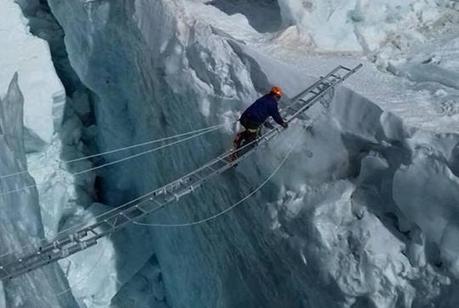A new route on Everest promises to make climbing the world's highest peak a bit safer. According to reports, the path bypasses the increasingly dangerous Khumbu Icefall, eliminating the most deadly and nerve-wracking part of the climb on the South Side of the mountain in Nepal.

Opening a New Route
Recently, mountaineers Alan Batard and Yorick Vion traveled to the Khumbu Valley in Nepal to search for alternate routes up Everest. Their goal was to find a safe and easily accessible path to Camp 2 that did not pass through the icefall. The pair-along with a support team-spent several weeks in the region seeking out a suitable new trail that would accomplish that goal, eventually discovering a promising new option.
The new route on Everest doesn't begin in the traditional base camp. Instead, alpinists would have to go up a nearby peak that until recently was both unnamed and unclimbed. Batard and his team made the first ascent last week, reaching the summit of the 5888-meter (19,317 feet) mountain. Shortly thereafter he named the mountain "Sundare" in honor of a Sherpa who served as a climbing mentor to him in the past.
After climbing Sundare, the new approach then links up to Everest somewhere above the Khumbu Icefall, connecting with the traditional South Col Route at Camp 2. Batard indicates that the ascent is roughly 700-meter (2296 feet) in length and involves traversing a rocky ridge and a snow slope. He says that his team fixed a kilometer of rope to mark the way and that he intends to return in the spring of 2022 to finish the connection.

Via Ferrata on Everest
The goal is to eventually install metal railings along the new route, turning it into a Via Ferrata of sorts. These so-called "iron paths" provide anchor points for climbers and trekkers, allowing them to safely traverse rocky trails that would otherwise be unsafe. This would seem to indicate that Batard's new approach will be steep and possibly treacherous, although the exact details have yet to be revealed.
Should this new route become a viable option, it will be interesting to see how many teams actually take advantage of it. It would potentially require a shift in logistics for commercial squads, who may no longer be operating out of the current base camp. Some of those teams-most notably Russel. Brice's Himex - have expressed concerns about the safety of the icefall in the past and may be looking for alternative options like this one.
Other major questions remain as well. For instance, will the new route support a large number of climbers? Will it turn into another bottleneck that could leave alpinists standing in line for hours? Can traffic move freely in both directions? We'll have to wait for Batard to fill us in on the details to better understand the long-term viability of this alternate way up Everest.
On Dangerous Ground
Whether or not this new route on Everest is one that will impact the future of the mountain remains to be seen. But, it is clear that the Khumbu continues to grow more perilous. The icefall has always been dangerous, but due to warming temperatures and melting ice, its shifting seracs are becoming increasingly less stable, making it more dangerous for climbers to pass through.
The route is maintained each year by a special group of Sherpas known as the "Ice Doctors." They scout and build a trail through the icefall by installing fixed ropes and placing ladders both horizontally and vertically across open crevasses. The trail changes from year to year and often has to be rebuilt several times each season as the towers of ice collapse. Because of this, the Khumbu is usually seen as the most dangerous place on Everest, even though it sits more than 3000 meters (9842 feet) below the summit.
While this is exciting news and could lead to safer Everest expeditions, it will likely be some time before we see Batard's new route used by larger groups of climbers. Still, any path that goes around the Khumbu Icefall is worth exploring. We should learn more come spring.



